Financial Markets Report: Trends, Derivatives, and Regulatory Impact
VerifiedAdded on 2023/01/12
|12
|2112
|42
Report
AI Summary
This report provides an in-depth analysis of financial markets, focusing on key trends in equity and fixed income markets across different regions. It examines the increasing trends in the equity markets of Japan and the USA and the decreasing trends in the European equity market. The report also differentiates between various types of bonds, including government, municipal, and corporate bonds, highlighting their associated risks and returns. Furthermore, it evaluates several financial derivatives, such as futures, forwards, options, and swaps, and their role in mitigating investment risk. The study also assesses the impact of technology and regulations, particularly Basel III, on stock and fixed-income markets from 2012 onward, concluding that technology and regulations play a significant role in the performance of financial markets.

Financial markets
Paraphrase This Document
Need a fresh take? Get an instant paraphrase of this document with our AI Paraphraser
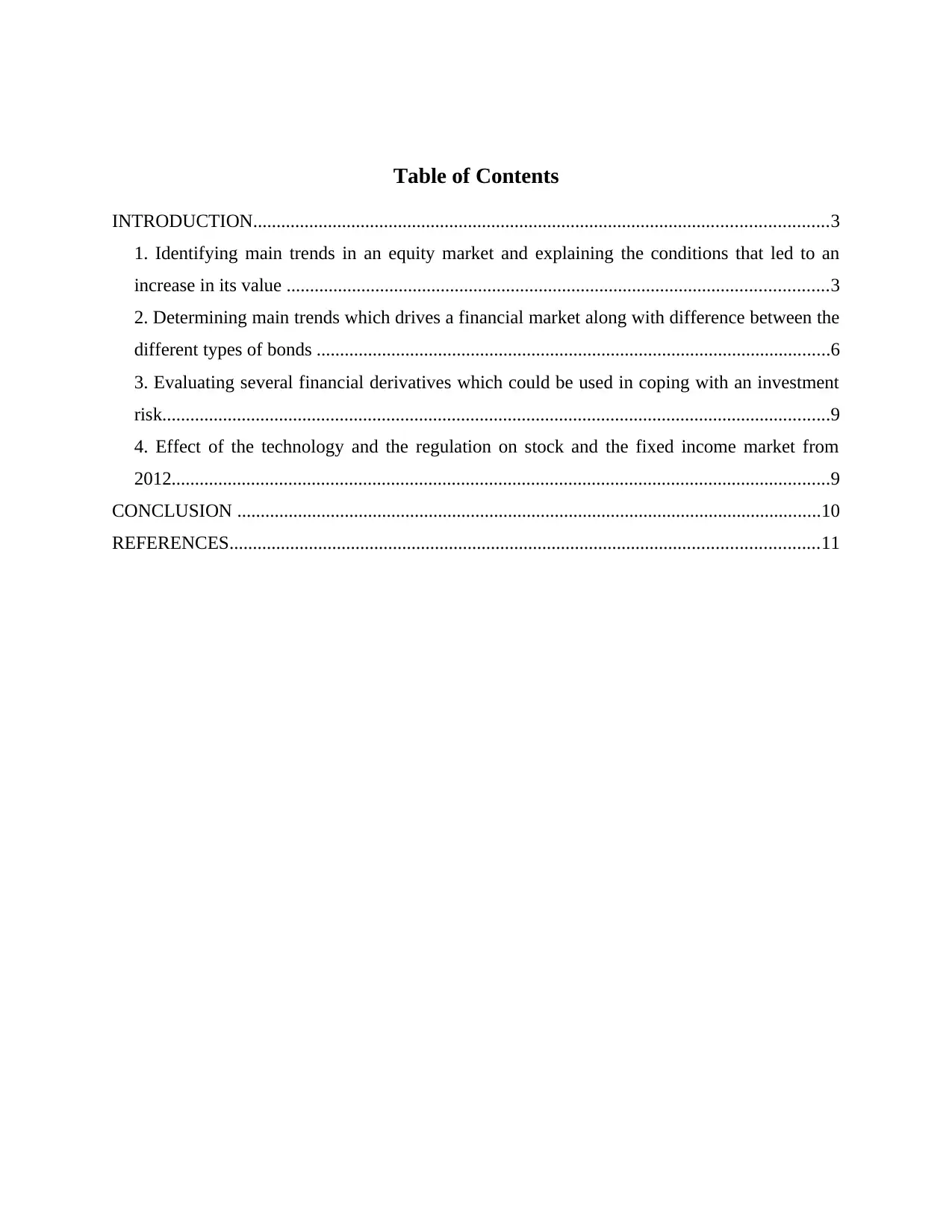
Table of Contents
INTRODUCTION...........................................................................................................................3
1. Identifying main trends in an equity market and explaining the conditions that led to an
increase in its value ....................................................................................................................3
2. Determining main trends which drives a financial market along with difference between the
different types of bonds ..............................................................................................................6
3. Evaluating several financial derivatives which could be used in coping with an investment
risk...............................................................................................................................................9
4. Effect of the technology and the regulation on stock and the fixed income market from
2012.............................................................................................................................................9
CONCLUSION .............................................................................................................................10
REFERENCES..............................................................................................................................11
INTRODUCTION...........................................................................................................................3
1. Identifying main trends in an equity market and explaining the conditions that led to an
increase in its value ....................................................................................................................3
2. Determining main trends which drives a financial market along with difference between the
different types of bonds ..............................................................................................................6
3. Evaluating several financial derivatives which could be used in coping with an investment
risk...............................................................................................................................................9
4. Effect of the technology and the regulation on stock and the fixed income market from
2012.............................................................................................................................................9
CONCLUSION .............................................................................................................................10
REFERENCES..............................................................................................................................11
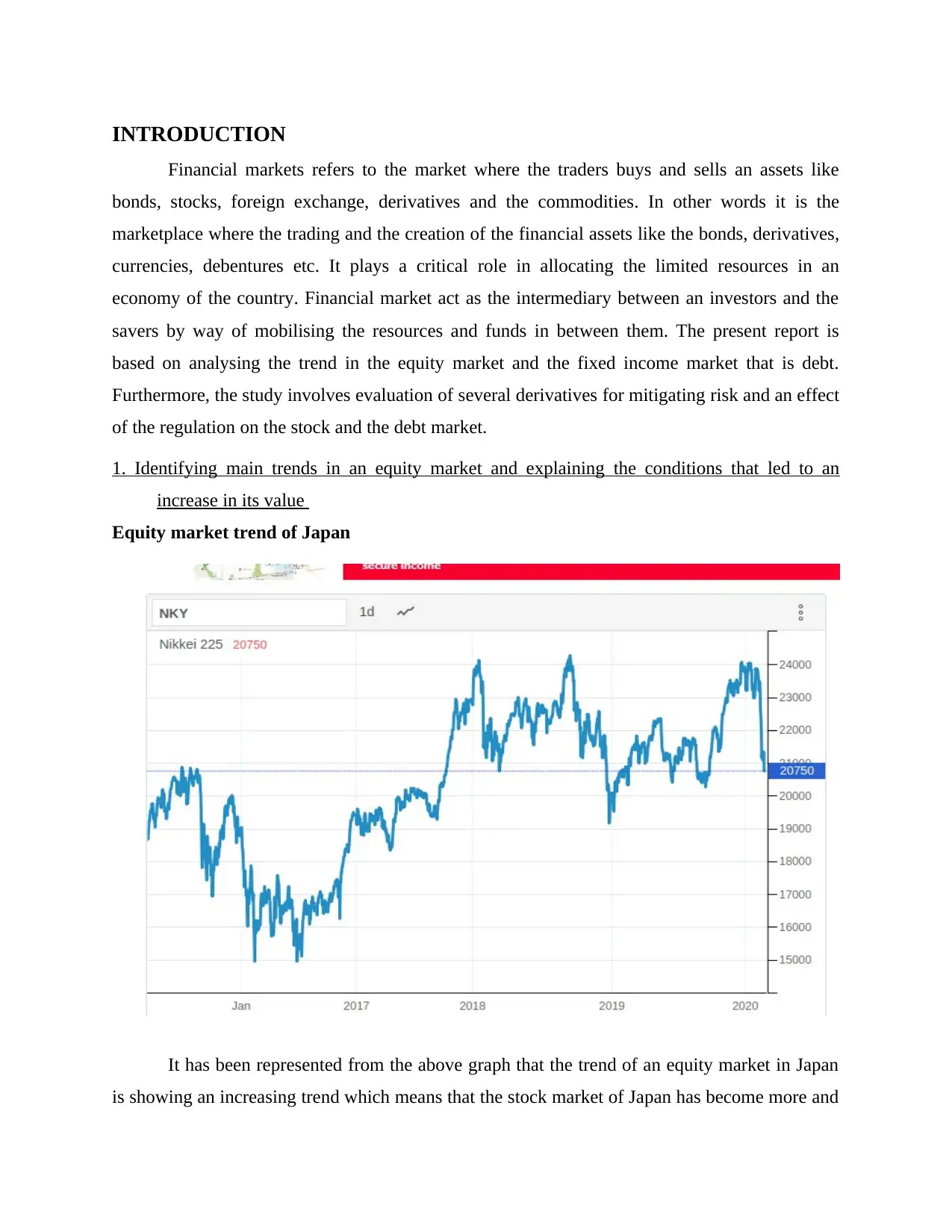
INTRODUCTION
Financial markets refers to the market where the traders buys and sells an assets like
bonds, stocks, foreign exchange, derivatives and the commodities. In other words it is the
marketplace where the trading and the creation of the financial assets like the bonds, derivatives,
currencies, debentures etc. It plays a critical role in allocating the limited resources in an
economy of the country. Financial market act as the intermediary between an investors and the
savers by way of mobilising the resources and funds in between them. The present report is
based on analysing the trend in the equity market and the fixed income market that is debt.
Furthermore, the study involves evaluation of several derivatives for mitigating risk and an effect
of the regulation on the stock and the debt market.
1. Identifying main trends in an equity market and explaining the conditions that led to an
increase in its value
Equity market trend of Japan
It has been represented from the above graph that the trend of an equity market in Japan
is showing an increasing trend which means that the stock market of Japan has become more and
Financial markets refers to the market where the traders buys and sells an assets like
bonds, stocks, foreign exchange, derivatives and the commodities. In other words it is the
marketplace where the trading and the creation of the financial assets like the bonds, derivatives,
currencies, debentures etc. It plays a critical role in allocating the limited resources in an
economy of the country. Financial market act as the intermediary between an investors and the
savers by way of mobilising the resources and funds in between them. The present report is
based on analysing the trend in the equity market and the fixed income market that is debt.
Furthermore, the study involves evaluation of several derivatives for mitigating risk and an effect
of the regulation on the stock and the debt market.
1. Identifying main trends in an equity market and explaining the conditions that led to an
increase in its value
Equity market trend of Japan
It has been represented from the above graph that the trend of an equity market in Japan
is showing an increasing trend which means that the stock market of Japan has become more and
⊘ This is a preview!⊘
Do you want full access?
Subscribe today to unlock all pages.

Trusted by 1+ million students worldwide
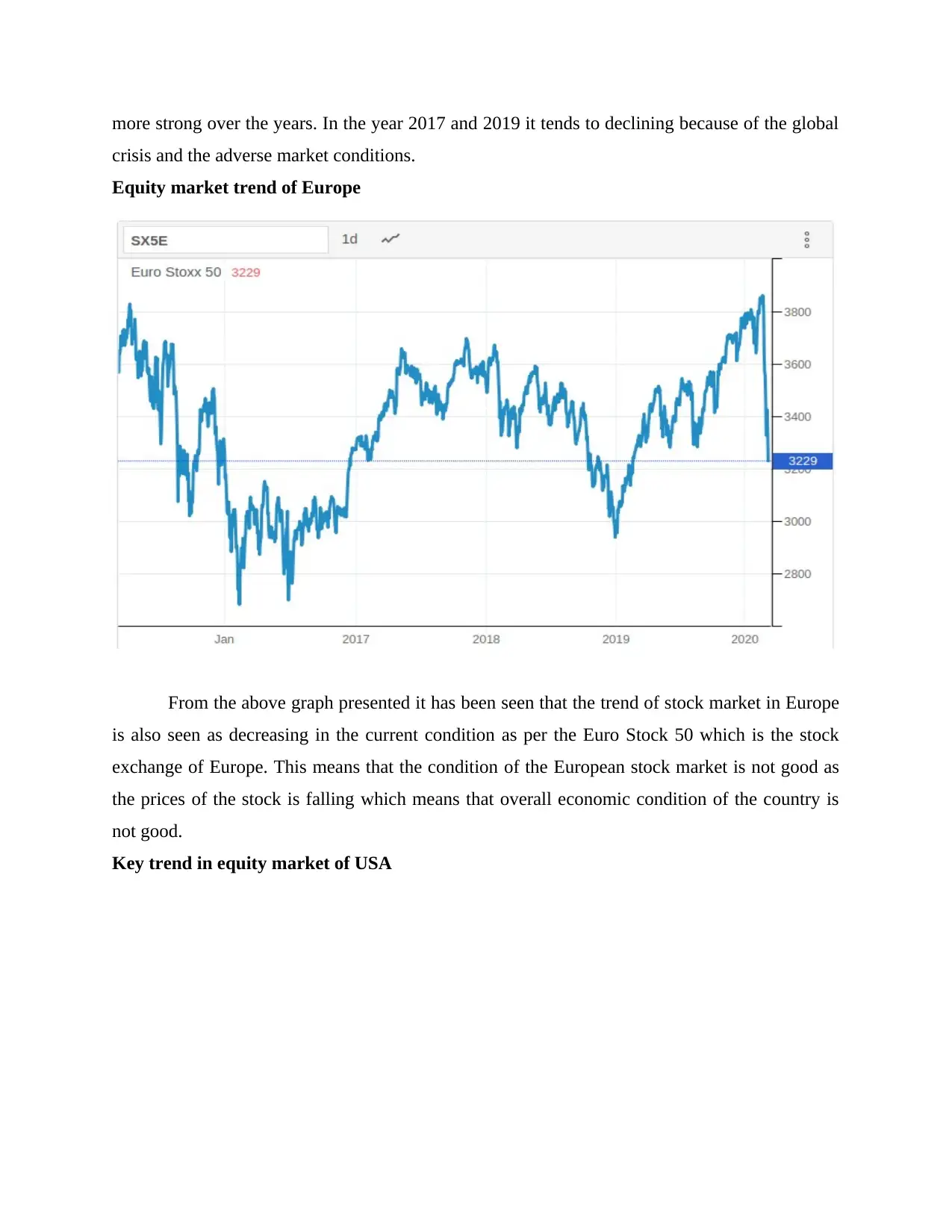
more strong over the years. In the year 2017 and 2019 it tends to declining because of the global
crisis and the adverse market conditions.
Equity market trend of Europe
From the above graph presented it has been seen that the trend of stock market in Europe
is also seen as decreasing in the current condition as per the Euro Stock 50 which is the stock
exchange of Europe. This means that the condition of the European stock market is not good as
the prices of the stock is falling which means that overall economic condition of the country is
not good.
Key trend in equity market of USA
crisis and the adverse market conditions.
Equity market trend of Europe
From the above graph presented it has been seen that the trend of stock market in Europe
is also seen as decreasing in the current condition as per the Euro Stock 50 which is the stock
exchange of Europe. This means that the condition of the European stock market is not good as
the prices of the stock is falling which means that overall economic condition of the country is
not good.
Key trend in equity market of USA
Paraphrase This Document
Need a fresh take? Get an instant paraphrase of this document with our AI Paraphraser
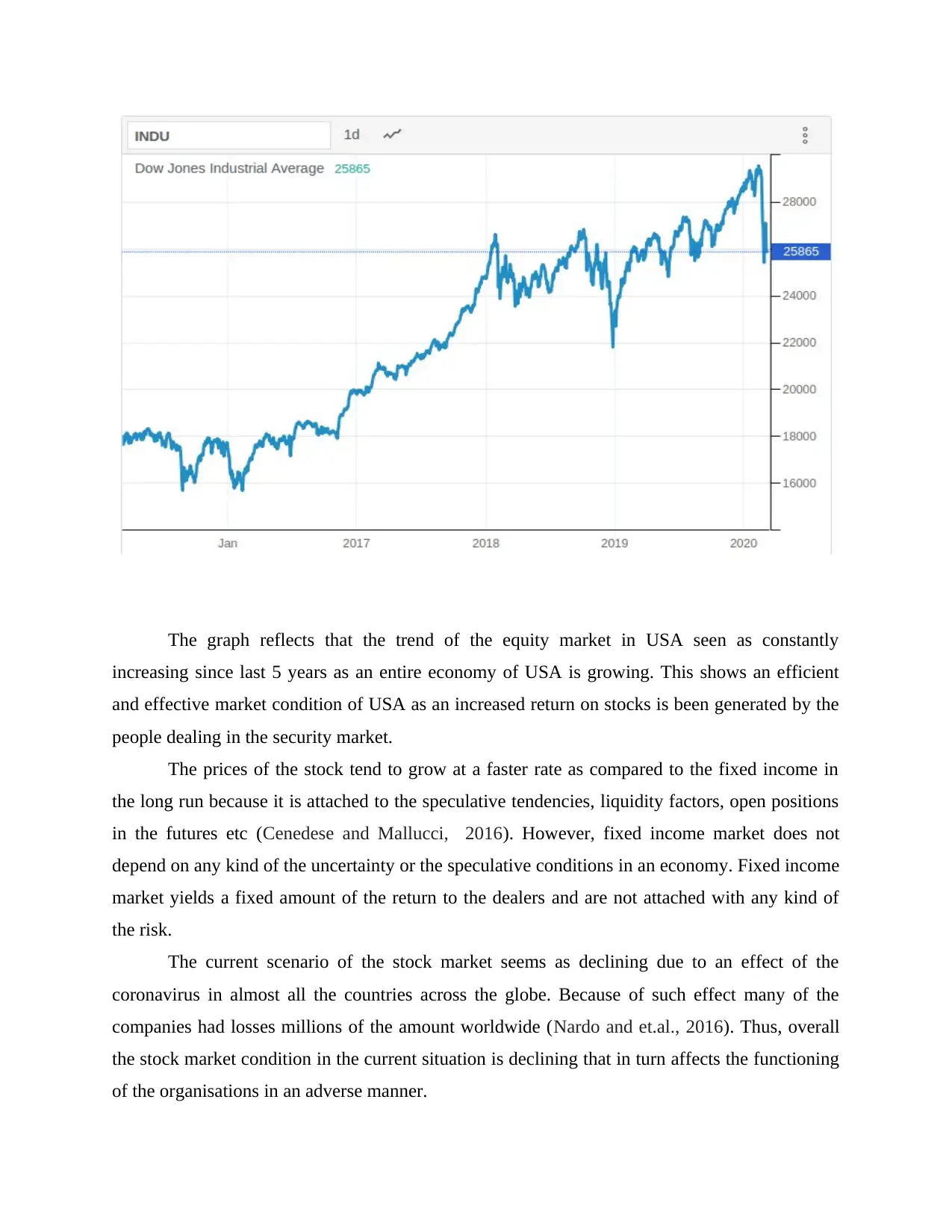
The graph reflects that the trend of the equity market in USA seen as constantly
increasing since last 5 years as an entire economy of USA is growing. This shows an efficient
and effective market condition of USA as an increased return on stocks is been generated by the
people dealing in the security market.
The prices of the stock tend to grow at a faster rate as compared to the fixed income in
the long run because it is attached to the speculative tendencies, liquidity factors, open positions
in the futures etc (Cenedese and Mallucci, 2016). However, fixed income market does not
depend on any kind of the uncertainty or the speculative conditions in an economy. Fixed income
market yields a fixed amount of the return to the dealers and are not attached with any kind of
the risk.
The current scenario of the stock market seems as declining due to an effect of the
coronavirus in almost all the countries across the globe. Because of such effect many of the
companies had losses millions of the amount worldwide (Nardo and et.al., 2016). Thus, overall
the stock market condition in the current situation is declining that in turn affects the functioning
of the organisations in an adverse manner.
increasing since last 5 years as an entire economy of USA is growing. This shows an efficient
and effective market condition of USA as an increased return on stocks is been generated by the
people dealing in the security market.
The prices of the stock tend to grow at a faster rate as compared to the fixed income in
the long run because it is attached to the speculative tendencies, liquidity factors, open positions
in the futures etc (Cenedese and Mallucci, 2016). However, fixed income market does not
depend on any kind of the uncertainty or the speculative conditions in an economy. Fixed income
market yields a fixed amount of the return to the dealers and are not attached with any kind of
the risk.
The current scenario of the stock market seems as declining due to an effect of the
coronavirus in almost all the countries across the globe. Because of such effect many of the
companies had losses millions of the amount worldwide (Nardo and et.al., 2016). Thus, overall
the stock market condition in the current situation is declining that in turn affects the functioning
of the organisations in an adverse manner.
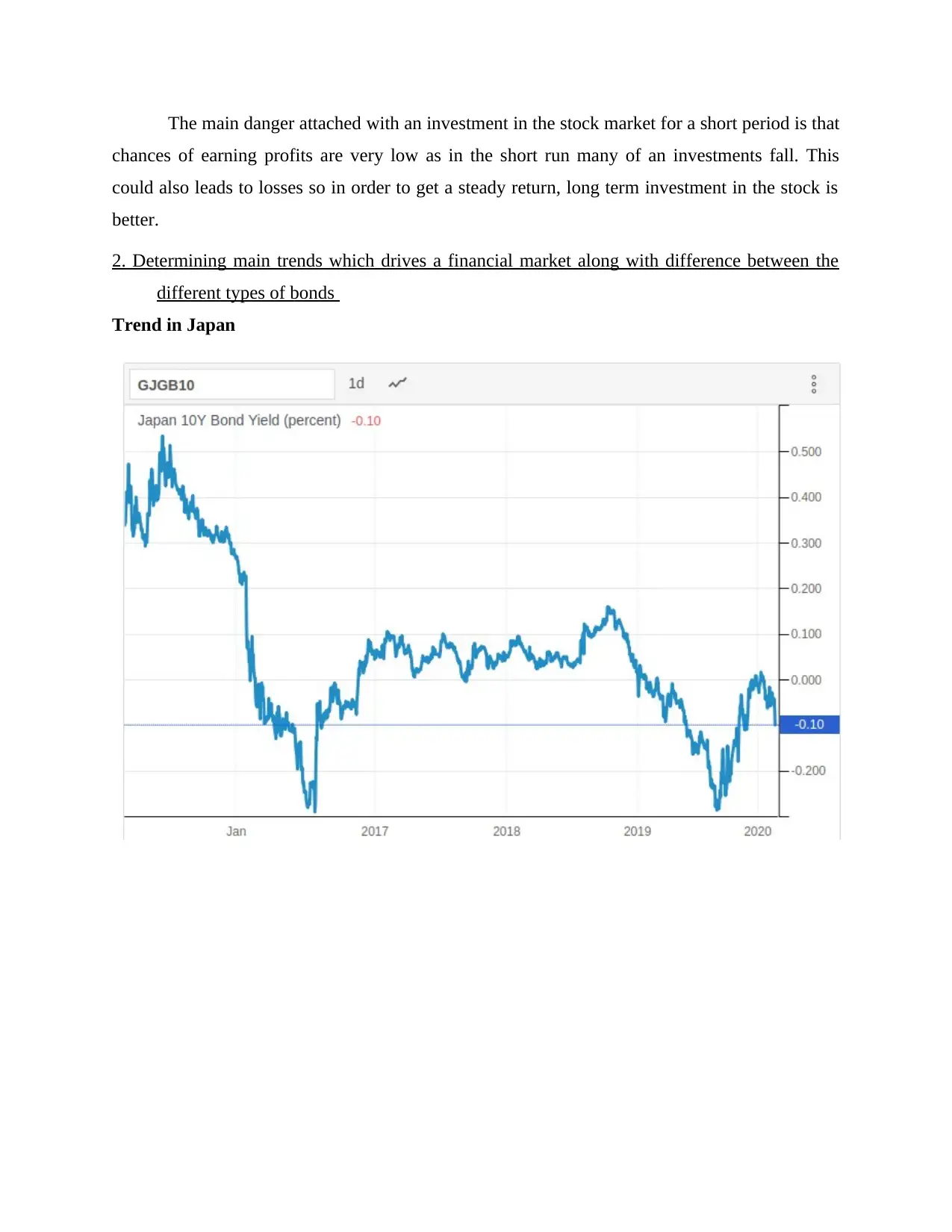
The main danger attached with an investment in the stock market for a short period is that
chances of earning profits are very low as in the short run many of an investments fall. This
could also leads to losses so in order to get a steady return, long term investment in the stock is
better.
2. Determining main trends which drives a financial market along with difference between the
different types of bonds
Trend in Japan
chances of earning profits are very low as in the short run many of an investments fall. This
could also leads to losses so in order to get a steady return, long term investment in the stock is
better.
2. Determining main trends which drives a financial market along with difference between the
different types of bonds
Trend in Japan
⊘ This is a preview!⊘
Do you want full access?
Subscribe today to unlock all pages.

Trusted by 1+ million students worldwide
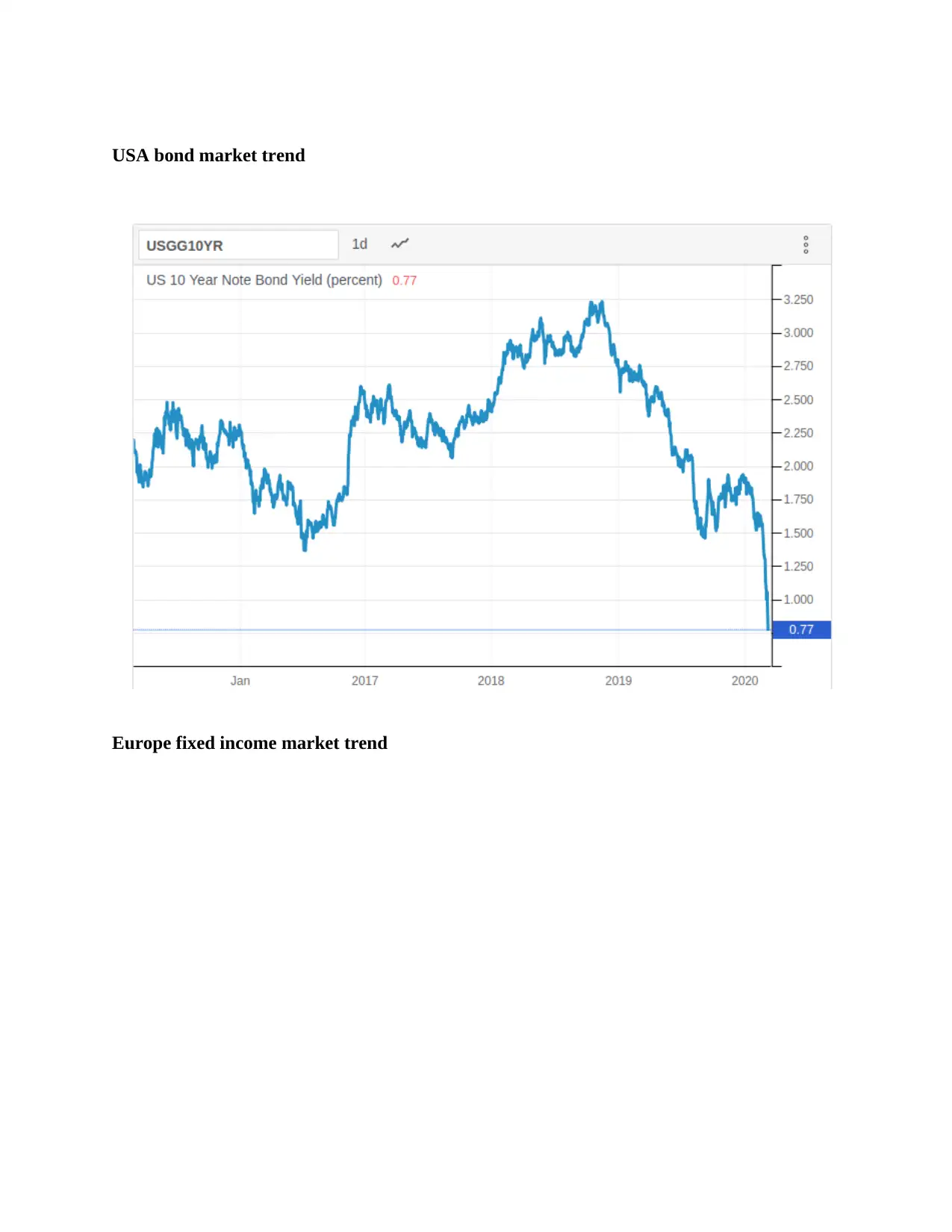
USA bond market trend
Europe fixed income market trend
Europe fixed income market trend
Paraphrase This Document
Need a fresh take? Get an instant paraphrase of this document with our AI Paraphraser
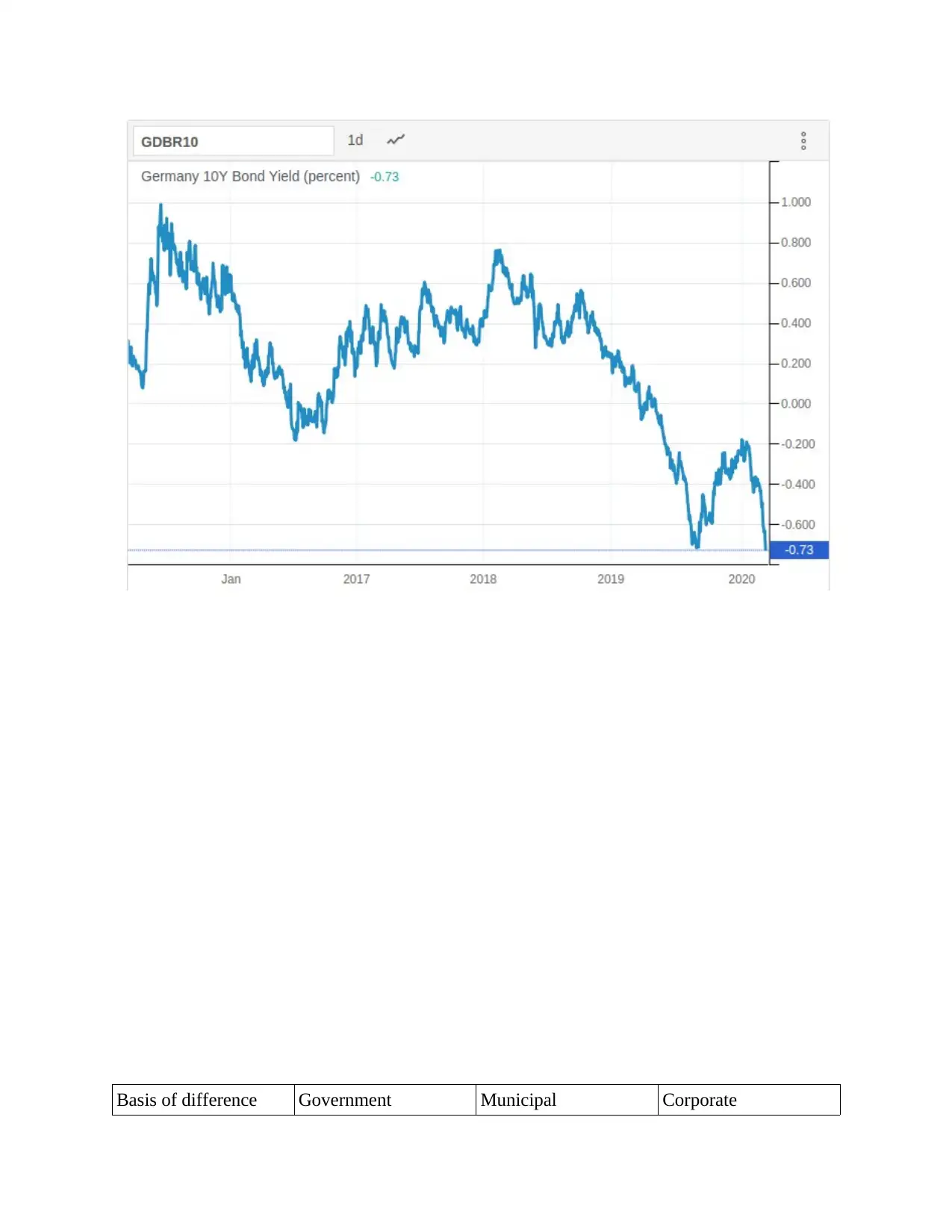
Basis of difference Government Municipal Corporate
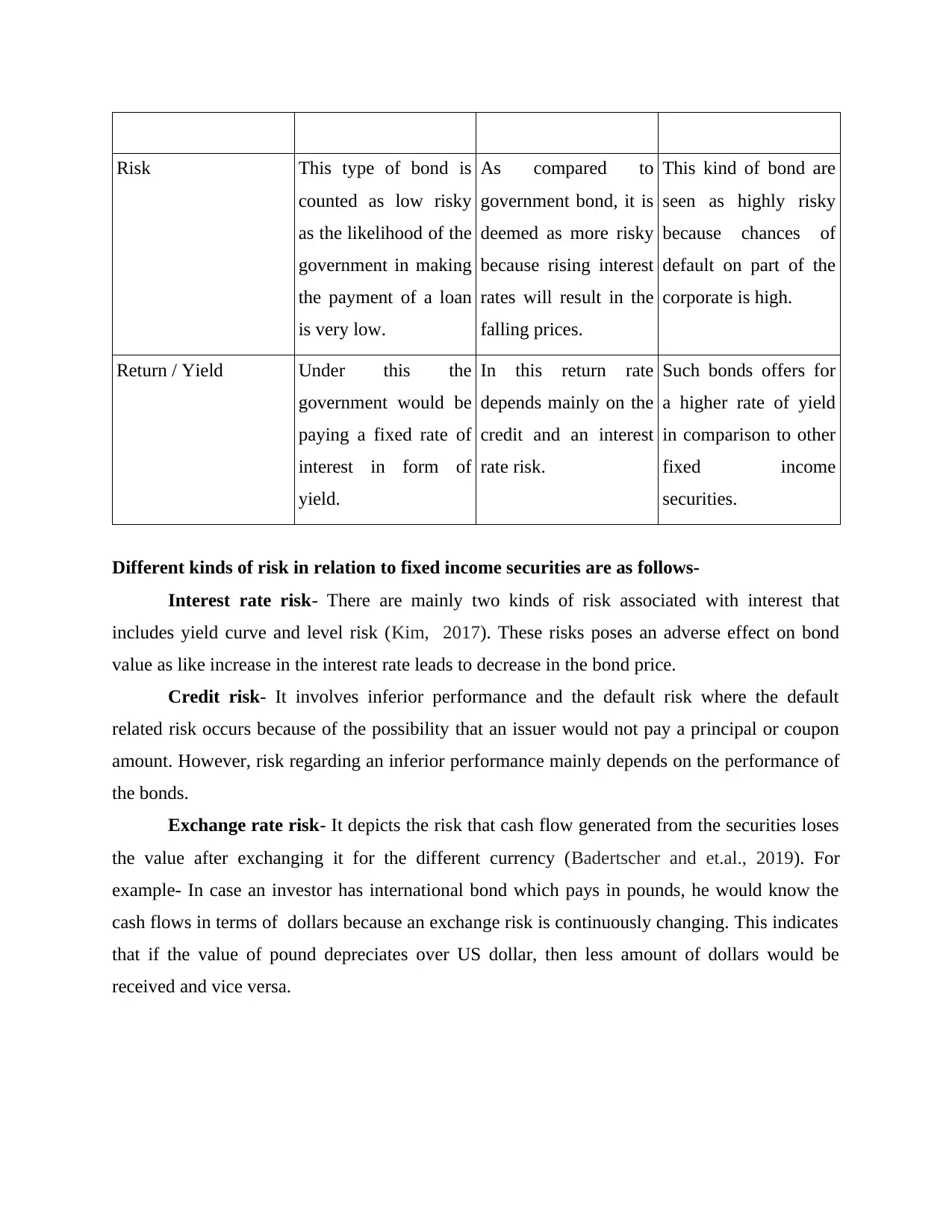
Risk This type of bond is
counted as low risky
as the likelihood of the
government in making
the payment of a loan
is very low.
As compared to
government bond, it is
deemed as more risky
because rising interest
rates will result in the
falling prices.
This kind of bond are
seen as highly risky
because chances of
default on part of the
corporate is high.
Return / Yield Under this the
government would be
paying a fixed rate of
interest in form of
yield.
In this return rate
depends mainly on the
credit and an interest
rate risk.
Such bonds offers for
a higher rate of yield
in comparison to other
fixed income
securities.
Different kinds of risk in relation to fixed income securities are as follows-
Interest rate risk- There are mainly two kinds of risk associated with interest that
includes yield curve and level risk (Kim, 2017). These risks poses an adverse effect on bond
value as like increase in the interest rate leads to decrease in the bond price.
Credit risk- It involves inferior performance and the default risk where the default
related risk occurs because of the possibility that an issuer would not pay a principal or coupon
amount. However, risk regarding an inferior performance mainly depends on the performance of
the bonds.
Exchange rate risk- It depicts the risk that cash flow generated from the securities loses
the value after exchanging it for the different currency (Badertscher and et.al., 2019). For
example- In case an investor has international bond which pays in pounds, he would know the
cash flows in terms of dollars because an exchange risk is continuously changing. This indicates
that if the value of pound depreciates over US dollar, then less amount of dollars would be
received and vice versa.
counted as low risky
as the likelihood of the
government in making
the payment of a loan
is very low.
As compared to
government bond, it is
deemed as more risky
because rising interest
rates will result in the
falling prices.
This kind of bond are
seen as highly risky
because chances of
default on part of the
corporate is high.
Return / Yield Under this the
government would be
paying a fixed rate of
interest in form of
yield.
In this return rate
depends mainly on the
credit and an interest
rate risk.
Such bonds offers for
a higher rate of yield
in comparison to other
fixed income
securities.
Different kinds of risk in relation to fixed income securities are as follows-
Interest rate risk- There are mainly two kinds of risk associated with interest that
includes yield curve and level risk (Kim, 2017). These risks poses an adverse effect on bond
value as like increase in the interest rate leads to decrease in the bond price.
Credit risk- It involves inferior performance and the default risk where the default
related risk occurs because of the possibility that an issuer would not pay a principal or coupon
amount. However, risk regarding an inferior performance mainly depends on the performance of
the bonds.
Exchange rate risk- It depicts the risk that cash flow generated from the securities loses
the value after exchanging it for the different currency (Badertscher and et.al., 2019). For
example- In case an investor has international bond which pays in pounds, he would know the
cash flows in terms of dollars because an exchange risk is continuously changing. This indicates
that if the value of pound depreciates over US dollar, then less amount of dollars would be
received and vice versa.
⊘ This is a preview!⊘
Do you want full access?
Subscribe today to unlock all pages.

Trusted by 1+ million students worldwide
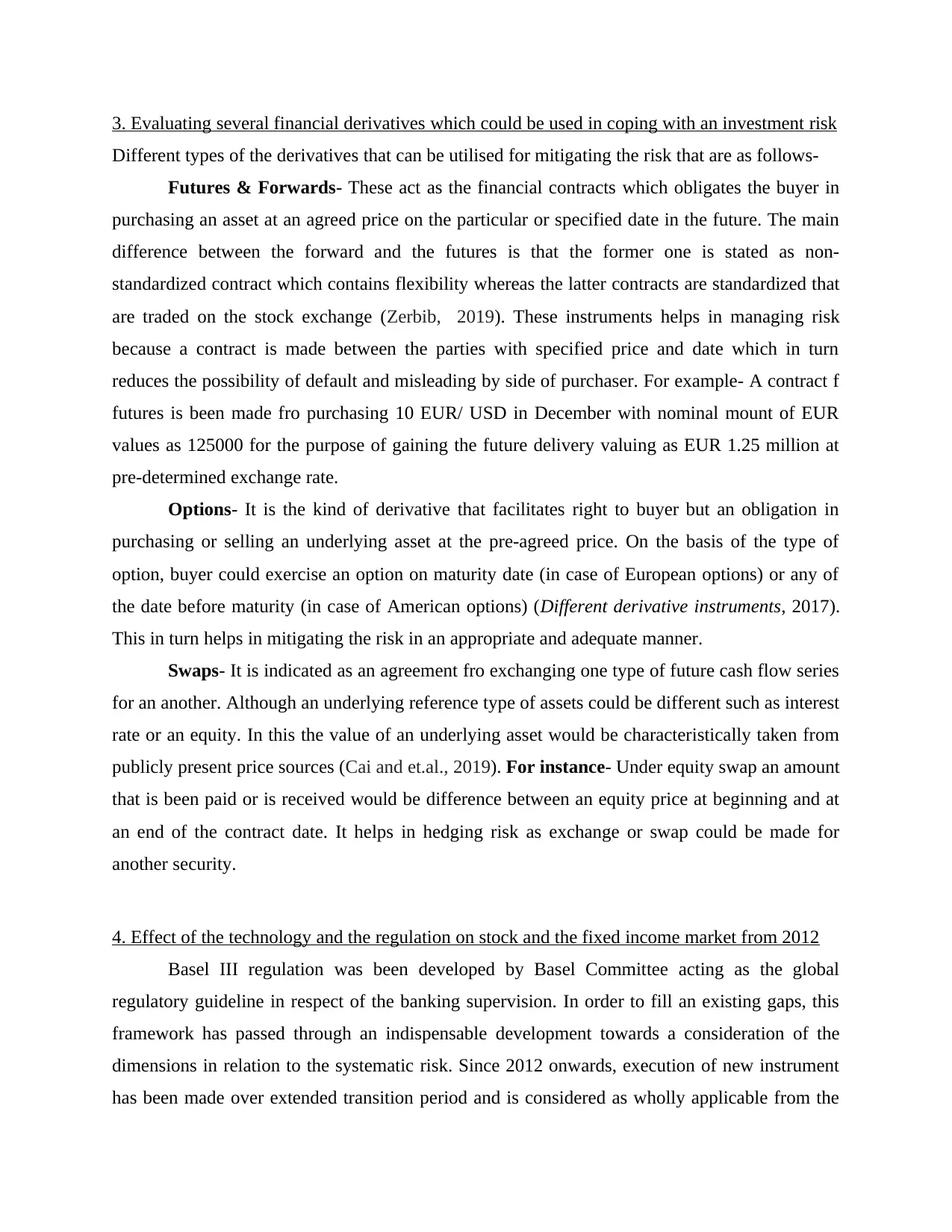
3. Evaluating several financial derivatives which could be used in coping with an investment risk
Different types of the derivatives that can be utilised for mitigating the risk that are as follows-
Futures & Forwards- These act as the financial contracts which obligates the buyer in
purchasing an asset at an agreed price on the particular or specified date in the future. The main
difference between the forward and the futures is that the former one is stated as non-
standardized contract which contains flexibility whereas the latter contracts are standardized that
are traded on the stock exchange (Zerbib, 2019). These instruments helps in managing risk
because a contract is made between the parties with specified price and date which in turn
reduces the possibility of default and misleading by side of purchaser. For example- A contract f
futures is been made fro purchasing 10 EUR/ USD in December with nominal mount of EUR
values as 125000 for the purpose of gaining the future delivery valuing as EUR 1.25 million at
pre-determined exchange rate.
Options- It is the kind of derivative that facilitates right to buyer but an obligation in
purchasing or selling an underlying asset at the pre-agreed price. On the basis of the type of
option, buyer could exercise an option on maturity date (in case of European options) or any of
the date before maturity (in case of American options) (Different derivative instruments, 2017).
This in turn helps in mitigating the risk in an appropriate and adequate manner.
Swaps- It is indicated as an agreement fro exchanging one type of future cash flow series
for an another. Although an underlying reference type of assets could be different such as interest
rate or an equity. In this the value of an underlying asset would be characteristically taken from
publicly present price sources (Cai and et.al., 2019). For instance- Under equity swap an amount
that is been paid or is received would be difference between an equity price at beginning and at
an end of the contract date. It helps in hedging risk as exchange or swap could be made for
another security.
4. Effect of the technology and the regulation on stock and the fixed income market from 2012
Basel III regulation was been developed by Basel Committee acting as the global
regulatory guideline in respect of the banking supervision. In order to fill an existing gaps, this
framework has passed through an indispensable development towards a consideration of the
dimensions in relation to the systematic risk. Since 2012 onwards, execution of new instrument
has been made over extended transition period and is considered as wholly applicable from the
Different types of the derivatives that can be utilised for mitigating the risk that are as follows-
Futures & Forwards- These act as the financial contracts which obligates the buyer in
purchasing an asset at an agreed price on the particular or specified date in the future. The main
difference between the forward and the futures is that the former one is stated as non-
standardized contract which contains flexibility whereas the latter contracts are standardized that
are traded on the stock exchange (Zerbib, 2019). These instruments helps in managing risk
because a contract is made between the parties with specified price and date which in turn
reduces the possibility of default and misleading by side of purchaser. For example- A contract f
futures is been made fro purchasing 10 EUR/ USD in December with nominal mount of EUR
values as 125000 for the purpose of gaining the future delivery valuing as EUR 1.25 million at
pre-determined exchange rate.
Options- It is the kind of derivative that facilitates right to buyer but an obligation in
purchasing or selling an underlying asset at the pre-agreed price. On the basis of the type of
option, buyer could exercise an option on maturity date (in case of European options) or any of
the date before maturity (in case of American options) (Different derivative instruments, 2017).
This in turn helps in mitigating the risk in an appropriate and adequate manner.
Swaps- It is indicated as an agreement fro exchanging one type of future cash flow series
for an another. Although an underlying reference type of assets could be different such as interest
rate or an equity. In this the value of an underlying asset would be characteristically taken from
publicly present price sources (Cai and et.al., 2019). For instance- Under equity swap an amount
that is been paid or is received would be difference between an equity price at beginning and at
an end of the contract date. It helps in hedging risk as exchange or swap could be made for
another security.
4. Effect of the technology and the regulation on stock and the fixed income market from 2012
Basel III regulation was been developed by Basel Committee acting as the global
regulatory guideline in respect of the banking supervision. In order to fill an existing gaps, this
framework has passed through an indispensable development towards a consideration of the
dimensions in relation to the systematic risk. Since 2012 onwards, execution of new instrument
has been made over extended transition period and is considered as wholly applicable from the
Paraphrase This Document
Need a fresh take? Get an instant paraphrase of this document with our AI Paraphraser
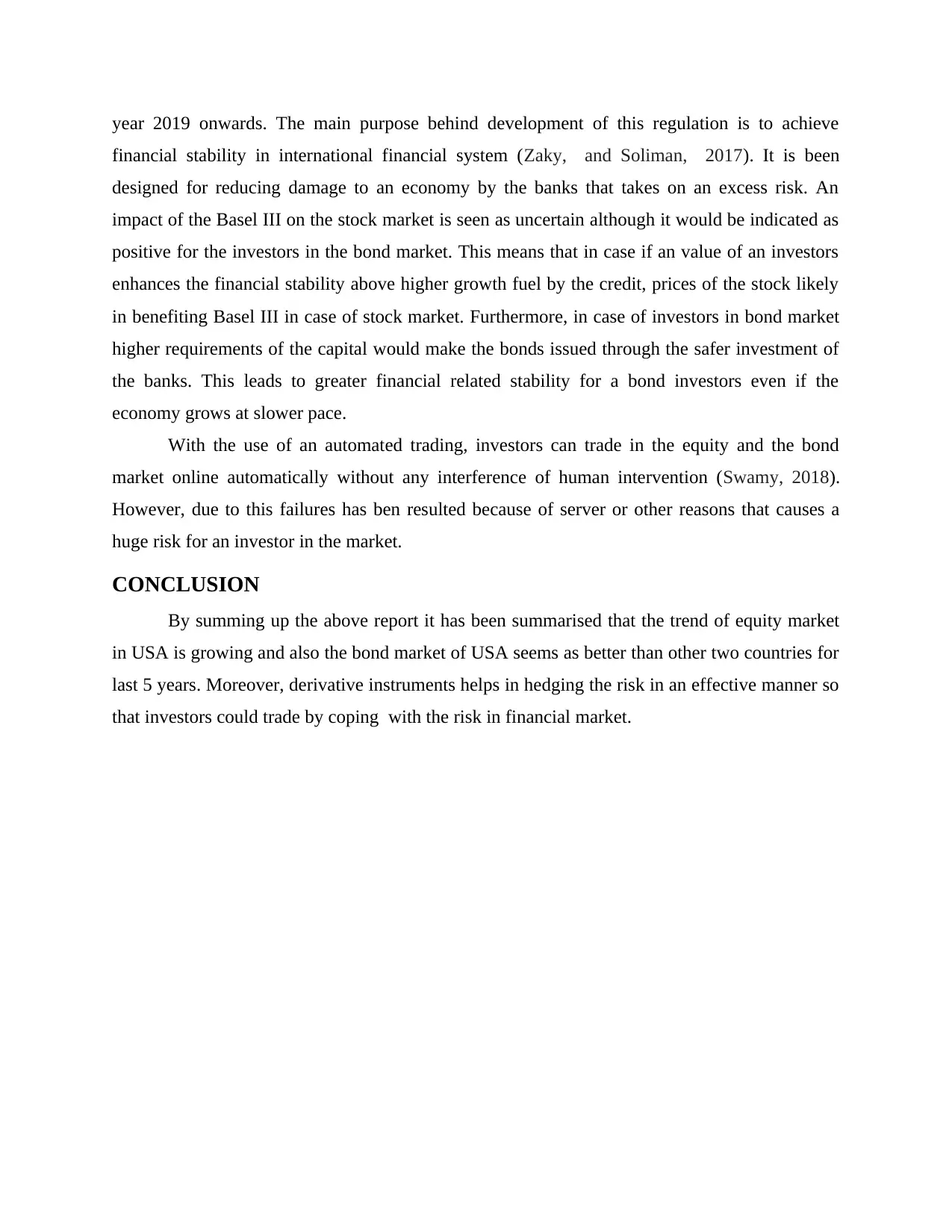
year 2019 onwards. The main purpose behind development of this regulation is to achieve
financial stability in international financial system (Zaky, and Soliman, 2017). It is been
designed for reducing damage to an economy by the banks that takes on an excess risk. An
impact of the Basel III on the stock market is seen as uncertain although it would be indicated as
positive for the investors in the bond market. This means that in case if an value of an investors
enhances the financial stability above higher growth fuel by the credit, prices of the stock likely
in benefiting Basel III in case of stock market. Furthermore, in case of investors in bond market
higher requirements of the capital would make the bonds issued through the safer investment of
the banks. This leads to greater financial related stability for a bond investors even if the
economy grows at slower pace.
With the use of an automated trading, investors can trade in the equity and the bond
market online automatically without any interference of human intervention (Swamy, 2018).
However, due to this failures has ben resulted because of server or other reasons that causes a
huge risk for an investor in the market.
CONCLUSION
By summing up the above report it has been summarised that the trend of equity market
in USA is growing and also the bond market of USA seems as better than other two countries for
last 5 years. Moreover, derivative instruments helps in hedging the risk in an effective manner so
that investors could trade by coping with the risk in financial market.
financial stability in international financial system (Zaky, and Soliman, 2017). It is been
designed for reducing damage to an economy by the banks that takes on an excess risk. An
impact of the Basel III on the stock market is seen as uncertain although it would be indicated as
positive for the investors in the bond market. This means that in case if an value of an investors
enhances the financial stability above higher growth fuel by the credit, prices of the stock likely
in benefiting Basel III in case of stock market. Furthermore, in case of investors in bond market
higher requirements of the capital would make the bonds issued through the safer investment of
the banks. This leads to greater financial related stability for a bond investors even if the
economy grows at slower pace.
With the use of an automated trading, investors can trade in the equity and the bond
market online automatically without any interference of human intervention (Swamy, 2018).
However, due to this failures has ben resulted because of server or other reasons that causes a
huge risk for an investor in the market.
CONCLUSION
By summing up the above report it has been summarised that the trend of equity market
in USA is growing and also the bond market of USA seems as better than other two countries for
last 5 years. Moreover, derivative instruments helps in hedging the risk in an effective manner so
that investors could trade by coping with the risk in financial market.
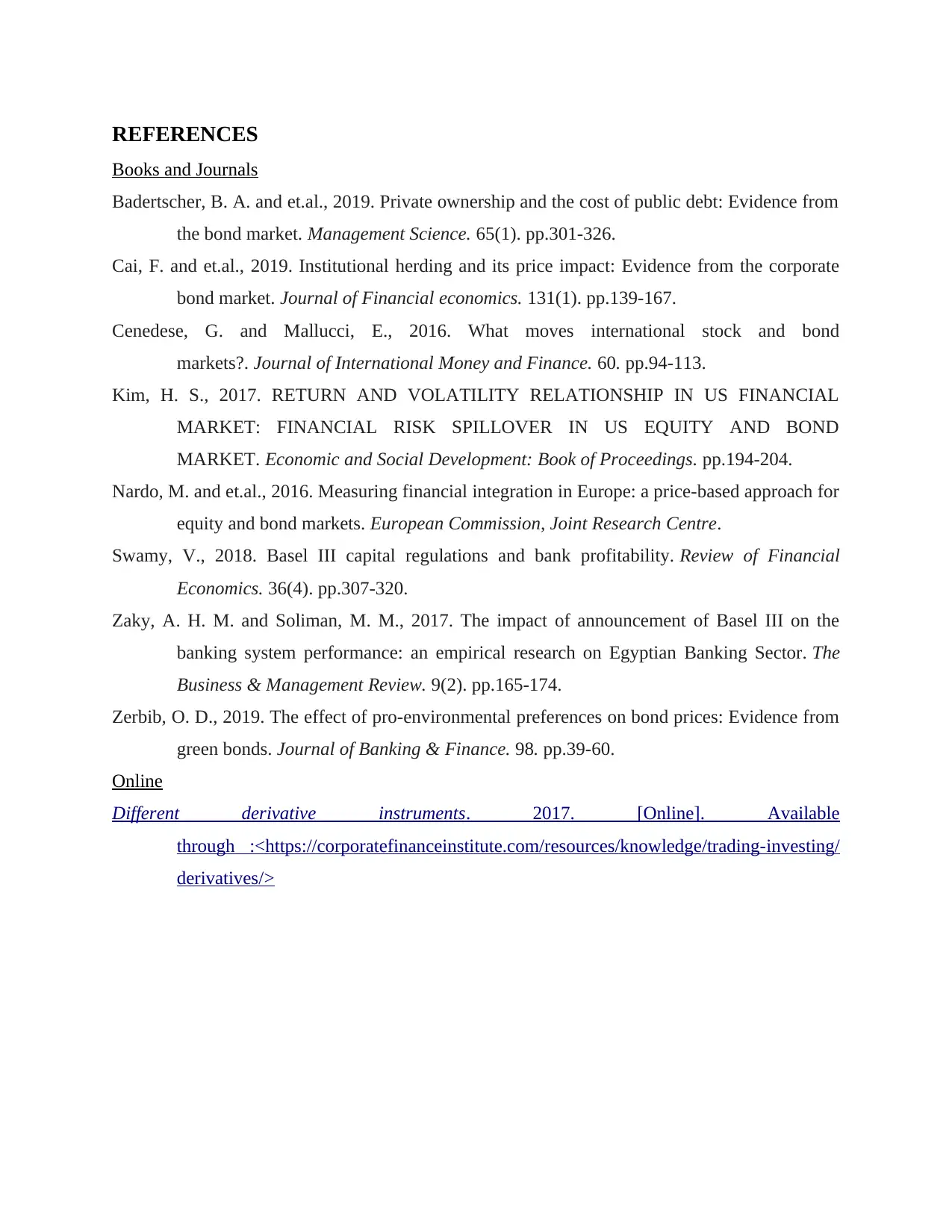
REFERENCES
Books and Journals
Badertscher, B. A. and et.al., 2019. Private ownership and the cost of public debt: Evidence from
the bond market. Management Science. 65(1). pp.301-326.
Cai, F. and et.al., 2019. Institutional herding and its price impact: Evidence from the corporate
bond market. Journal of Financial economics. 131(1). pp.139-167.
Cenedese, G. and Mallucci, E., 2016. What moves international stock and bond
markets?. Journal of International Money and Finance. 60. pp.94-113.
Kim, H. S., 2017. RETURN AND VOLATILITY RELATIONSHIP IN US FINANCIAL
MARKET: FINANCIAL RISK SPILLOVER IN US EQUITY AND BOND
MARKET. Economic and Social Development: Book of Proceedings. pp.194-204.
Nardo, M. and et.al., 2016. Measuring financial integration in Europe: a price-based approach for
equity and bond markets. European Commission, Joint Research Centre.
Swamy, V., 2018. Basel III capital regulations and bank profitability. Review of Financial
Economics. 36(4). pp.307-320.
Zaky, A. H. M. and Soliman, M. M., 2017. The impact of announcement of Basel III on the
banking system performance: an empirical research on Egyptian Banking Sector. The
Business & Management Review. 9(2). pp.165-174.
Zerbib, O. D., 2019. The effect of pro-environmental preferences on bond prices: Evidence from
green bonds. Journal of Banking & Finance. 98. pp.39-60.
Online
Different derivative instruments. 2017. [Online]. Available
through :<https://corporatefinanceinstitute.com/resources/knowledge/trading-investing/
derivatives/>
Books and Journals
Badertscher, B. A. and et.al., 2019. Private ownership and the cost of public debt: Evidence from
the bond market. Management Science. 65(1). pp.301-326.
Cai, F. and et.al., 2019. Institutional herding and its price impact: Evidence from the corporate
bond market. Journal of Financial economics. 131(1). pp.139-167.
Cenedese, G. and Mallucci, E., 2016. What moves international stock and bond
markets?. Journal of International Money and Finance. 60. pp.94-113.
Kim, H. S., 2017. RETURN AND VOLATILITY RELATIONSHIP IN US FINANCIAL
MARKET: FINANCIAL RISK SPILLOVER IN US EQUITY AND BOND
MARKET. Economic and Social Development: Book of Proceedings. pp.194-204.
Nardo, M. and et.al., 2016. Measuring financial integration in Europe: a price-based approach for
equity and bond markets. European Commission, Joint Research Centre.
Swamy, V., 2018. Basel III capital regulations and bank profitability. Review of Financial
Economics. 36(4). pp.307-320.
Zaky, A. H. M. and Soliman, M. M., 2017. The impact of announcement of Basel III on the
banking system performance: an empirical research on Egyptian Banking Sector. The
Business & Management Review. 9(2). pp.165-174.
Zerbib, O. D., 2019. The effect of pro-environmental preferences on bond prices: Evidence from
green bonds. Journal of Banking & Finance. 98. pp.39-60.
Online
Different derivative instruments. 2017. [Online]. Available
through :<https://corporatefinanceinstitute.com/resources/knowledge/trading-investing/
derivatives/>
⊘ This is a preview!⊘
Do you want full access?
Subscribe today to unlock all pages.

Trusted by 1+ million students worldwide
1 out of 12
Related Documents
Your All-in-One AI-Powered Toolkit for Academic Success.
+13062052269
info@desklib.com
Available 24*7 on WhatsApp / Email
![[object Object]](/_next/static/media/star-bottom.7253800d.svg)
Unlock your academic potential
Copyright © 2020–2025 A2Z Services. All Rights Reserved. Developed and managed by ZUCOL.





